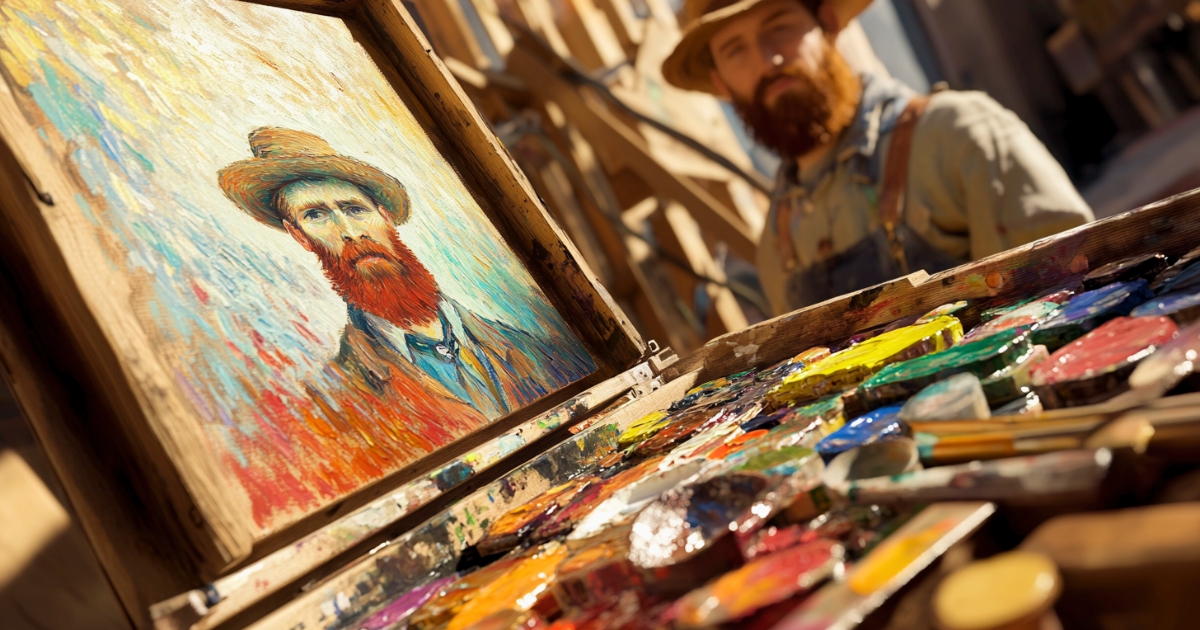Vincent van Gogh. When you hear this name, many of you might envision vibrant yellow sunflowers or a swirling blue night sky. This Dutch painter, who was active in the latter half of the 19th century, is renowned for his unique use of color. However, behind the captivating colors of Van Gogh’s works lies a meticulous process of research and experimentation. In this article, we’ll focus on Van Gogh’s paint box and delve into the secrets of his color expression.
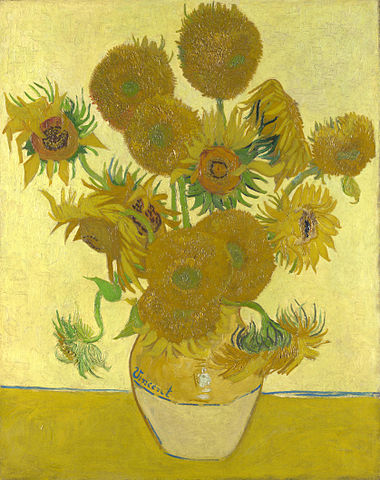
Van Gogh’s masterpiece ‘Sunflowers’ (1888). Painted primarily with chrome yellow, it uses multiple yellow pigments. This work can be considered the culmination of Van Gogh’s color experiments. By Vincent van Gogh
The New Paints Van Gogh Loved
The 19th century brought about a revolution in the art world. At the center of this revolution was the emergence of new paints. Van Gogh eagerly embraced these new paints, incorporating them into his works.
Among the new paints, Van Gogh was particularly known for his extensive use of chrome yellow and cobalt blue. Chrome yellow, discovered in 1809, was a vivid yellow pigment that was brighter and more light-resistant than previous yellow pigments. This color, used in Van Gogh’s iconic “Sunflowers” series, leaves a strong impression on viewers.
On the other hand, cobalt blue, discovered in 1803, was a deep blue pigment. This color greatly contributed to the expression of the mystical and profound blue night sky seen in Van Gogh’s “The Starry Night”.
These new paints greatly expanded Van Gogh’s range of color expression. He not only used these paints but also mixed them in unique ways to create new colors.
Van Gogh himself wrote in a letter to his brother Theo on July 31, 1888:
“I’m in a frenzy of work as the trees are in blossom and I wanted to paint a Provençal orchard of astonishing gaiety. Yesterday I finished a canvas of a ‘Pink Peach Tree’, today I’m going to attack a ‘Plum Tree’.”
These words reveal Van Gogh’s sensitivity to color and his experimental attitude.
Van Gogh’s Color Experiments
The secret of Van Gogh’s color expression wasn’t just in using new paints. He constructed his unique color world through constant experimentation and research.
For example, Van Gogh tried to maximize the effect of colors by placing complementary colors side by side. Combinations of complementary colors such as red and green, blue and orange, yellow and purple enhance each other and bring vibrancy to the canvas. In “Café Terrace at Night”, the contrast between the yellow light of the café and the blue of the night sky creates a unique atmosphere in the work.
Van Gogh also favored the technique of applying paint thickly (impasto). This allowed him to utilize the physical texture of the paint, enhancing the effects of light reflection and shadow. In “Road with Cypress and Star”, the thickly applied paint around the stars and moon expresses the flickering of light.
Scientific analyses of Van Gogh’s color experiments have also been conducted. For instance, a joint research team from the Van Gogh Museum in Amsterdam and the University of Antwerp used X-ray fluorescence analysis to study Van Gogh’s paintings. The results revealed that in the “Sunflowers” series, not only chrome yellow but also cadmium yellow and zinc yellow were used. This shows that Van Gogh was skillfully combining multiple colors to create unique color effects, rather than using a single color.
19th Century Color Theory and Van Gogh
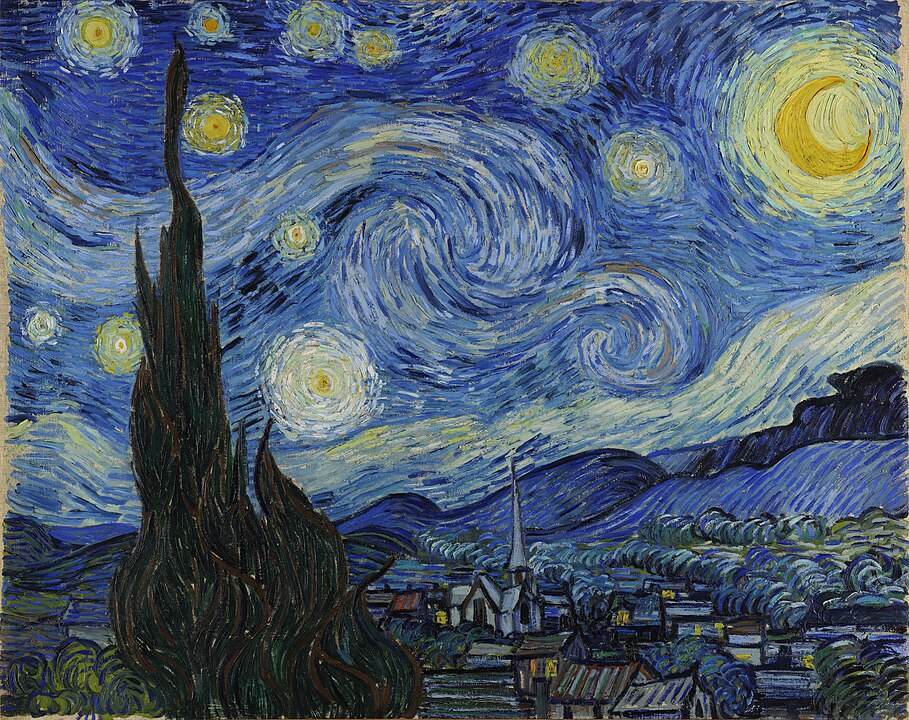
‘The Starry Night’ (1889). The contrast between the night sky painted with cobalt blue and the stars with chrome yellow is striking. This work is a prime example of the fusion of Van Gogh’s color theory and emotional expression. By Vincent van Gogh
Van Gogh’s color expression was also greatly influenced by the latest color theories of his time. In particular, the theory of simultaneous color contrast proposed by French chemist Michel Eugène Chevreul had a significant impact on Van Gogh’s work.
According to Chevreul’s theory, adjacent colors influence each other and change their appearance. Many color combinations in Van Gogh’s works align with this theory. While there’s debate about whether he consciously applied the theory, there’s no doubt that his keen sense of color resulted in works that adhered to the theory.
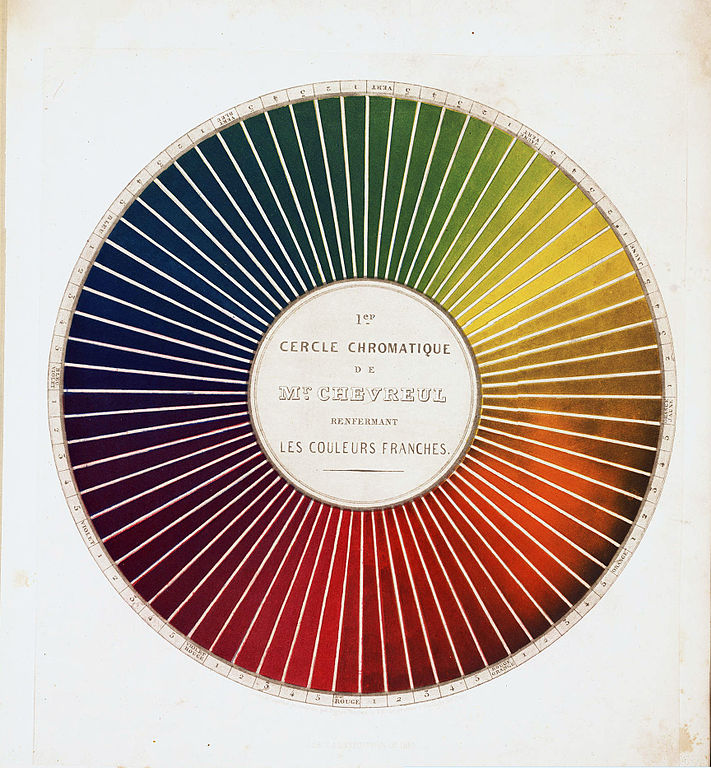
Chevreul’s color wheel. This theory demonstrates the concept of ‘simultaneous color contrast’ where adjacent colors influence each other. Van Gogh actively incorporated this theory into his works to maximize color effects. Michel Chevreul
Van Gogh was also influenced by the color division technique practiced by Impressionist painters. This technique involves juxtaposing pure colors with small brushstrokes, expecting the colors to mix in the viewer’s eye. Van Gogh developed this technique in his own way, using bolder, more expressionistic brushstrokes to juxtapose colors.
In a letter dated August 18, 1888, Van Gogh wrote about color theory:
“Color expresses something in itself. One can’t do without this, one must use it; what is beautiful, really beautiful — is also correct.”
These words show that Van Gogh viewed color theory not just as technical knowledge, but as an essential element of artistic expression.
The Fusion of Science and Art
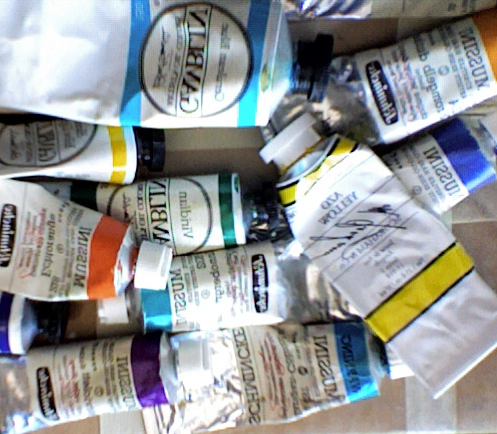
Paint tubes that emerged in the 19th century. These allowed artists to easily paint outdoors, contributing to the development of Impressionism. Van Gogh also actively utilized this new technology. By Bus stop, CC BY-SA 3.0, Link
The 19th century was an era when scientific and technological developments greatly influenced the art world. The invention of new synthetic pigments and the introduction of paint tubes greatly expanded artists’ range of expression.
While actively embracing these new technologies, Van Gogh also valued the observation of nature. His letters contain detailed observational records of color and light effects. The fusion of scientific accuracy and artistic sensibility created Van Gogh’s unique color world.
For example, as Van Gogh worked under the strong sunlight of southern France, he became more conscious of the effects of complementary colors. In “The Langlois Bridge at Arles”, the contrast between the blue sky and the yellow wheat field beautifully expresses the intense light of southern France.
Recent scientific analyses have revealed the types and combinations of pigments used in Van Gogh’s works. For instance, a research team from the National Gallery of Art in America used Raman spectroscopy to analyze Van Gogh’s “Irises” and discovered that cobalt blue and carmine red were used for the blue-purple petals. This combination was innovative for its time and demonstrates an aspect of Van Gogh’s color experiments.
The Influence of Van Gogh’s Colors on Modern Art
Van Gogh’s bold use of color has had a profound influence on 20th-century art after his death. In particular, the Fauvist painters were strongly influenced by Van Gogh’s color expression. Artists like Henri Matisse and André Derain took Van Gogh’s bold use of color even further, developing it into more abstract expressions.
Abstract Expressionist painters also learned much from Van Gogh’s emotional color expression. It’s said that Wassily Kandinsky realized that color alone could express emotion after seeing Van Gogh’s work.
Even in the world of contemporary digital art, Van Gogh’s color theory continues to play an important role. Modern artists who manipulate color using digital technology incorporate the theory of complementary colors and the emotional effects of color that Van Gogh practiced into their own works.
For example, digital artist Refik Anadol created a work titled “Machine Hallucinations – Space: Metaverse” inspired by Van Gogh’s “The Starry Night”. This work uses artificial intelligence to analyze Van Gogh’s brushstrokes and colors, creating a new digital space based on this analysis. Anadol is exploring new possibilities in artistic expression by fusing Van Gogh’s color theory with modern technology.
Additionally, virtual reality (VR) artist Matt Pyke created a VR work called “Night Cafe”. This is a 3D recreation of Van Gogh’s “The Night Café”, allowing viewers to walk around in Van Gogh’s color world. By faithfully reproducing Van Gogh’s colors and brushstrokes, Pyke creates an immersive experience that can’t be achieved with a two-dimensional painting.
These examples show that Van Gogh’s color theory is not merely a relic of the past, but continues to be a source of creativity in contemporary digital art. The possibilities of color that Van Gogh explored are being further developed through their connection with new technologies.
Conclusion: What Van Gogh’s Paint Box Tells Us
Van Gogh’s paint box was not just a collection of art supplies. It was a place where 19th-century scientific and technological developments intersected with one artist’s passion. The encounter with new paints, the study of color theory, and constant experimentation all shaped Van Gogh’s unique color world.
We are fascinated by Van Gogh’s works today not just because of their vivid color expression. They reflect the attitude of an artist who continually pursued new forms of expression. Van Gogh’s paint box teaches us the importance of innovation and experimentation in art.
Van Gogh’s color revolution continues to influence the contemporary art scene, extending beyond his own era. Scientific analysis of Van Gogh’s works will continue, and new discoveries will undoubtedly inspire many more artists.
What Van Gogh’s paint box tells us is about the fusion of art and science, and an insatiable quest for innovation. This spirit continues to shine as a source of creativity even in the age of digital art. Van Gogh’s color revolution continues to unfold before our eyes.
